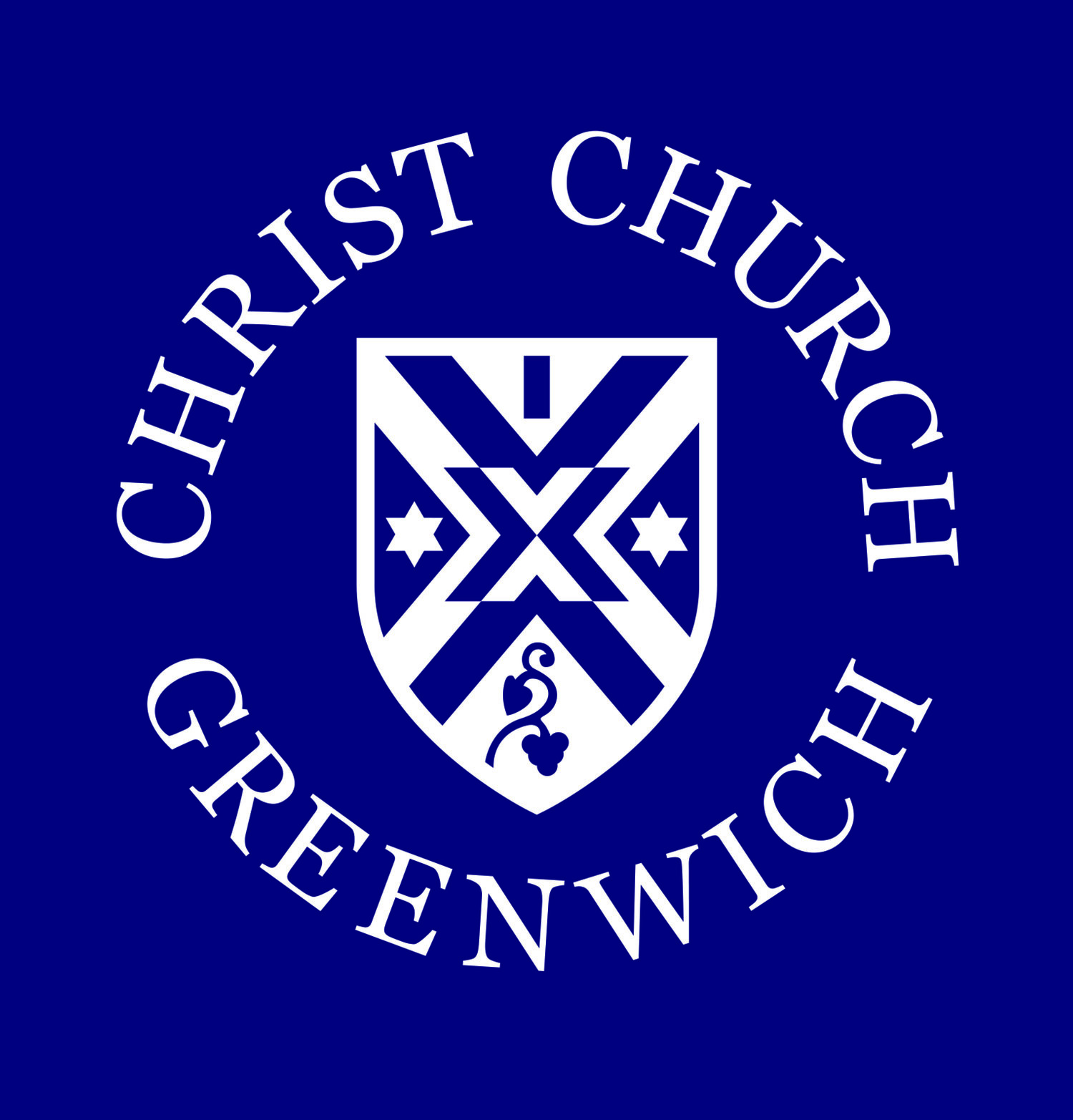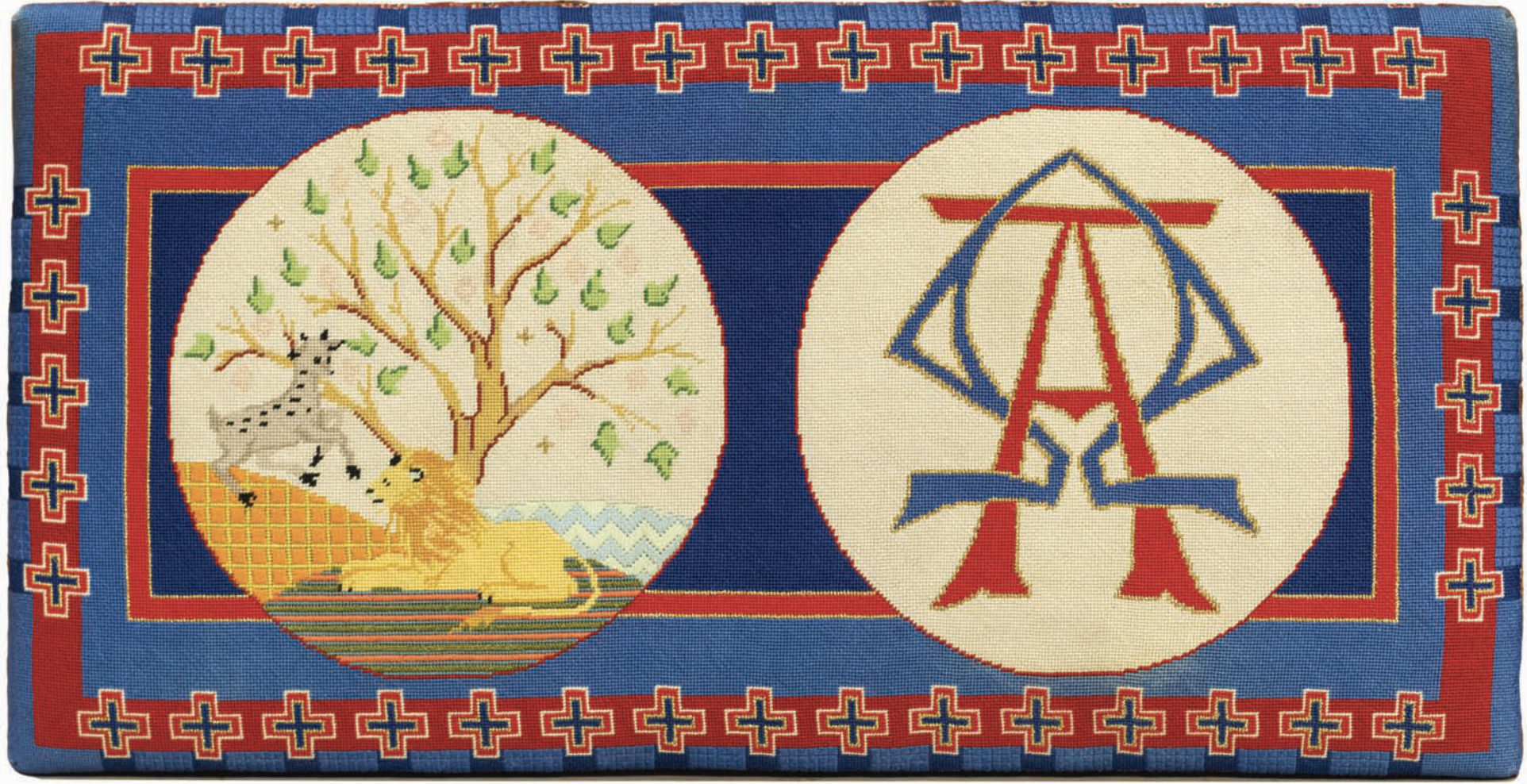Framed Legend to the Altar Rail Needlepoint Kneelers
This Legend illustrates and explains the Twelve Needlepoint Kneeler Cushions at the Main Altar. Veva Wood Crozier, who designed the kneelers, drew the kneeler images in the Legend and composed the Legend text; lettering is by Joan D. Binkerd.
“The sanctuary needlepoint, dedicated April 22, 1979, was initiated by the Altar Guild and completed by talented hands and memorial gifts.”—Book of Memory.
Needlepointers: Mrs. William Chisholm, Mrs. Karl Davies, Mrs. William Hurd, Mrs. Herbert Marache, Mrs. William F. Preston, Mrs. Brendan G. Rafferty, Miss Marguerite St. George-Smith, Mrs. Richard P. Selchow, Mrs. J.S.B. Smith, Mrs. Robert Wallace
The Legend is found on the east wall of Rectors’ Gallery
NOTE: In the Kneeler images that follow, verses from Ecclesiastes 3:1-8 are in bold italics.
All other text and quotes are as written on the Needlepoint Legend.
Kneeler 1
A time to be born and a time to die
Birth: The phoenix was introduced into Christian symbolism as early as the first century. The fabled bird, reborn from its own ashes, has long been a symbol of “the triumph of life over death.”
Death: The owl, “bird of the night and darkness, symbolizes death, night, cold, solitude”. The owl like the phoenix is a very old and widely used symbol. The American Indian believed that the owl summoned one to death by speaking one’s name. Currently, the bird has come to symbolize Satan, “The Prince of Darkness.”
A time to plant and a time to pluck up that which is planted
Plant: “The bull is a common embodiment of the corn spirit of Northern Europe” and as such was responsible for the planting seasons. “Also, in ancient mythology, the bull was the emblem of the moon.” Even today the moon is considered important to the planting of crops.
Pluck: The quail has been used to represent God’s bountiful providence as in Exodus 16:12 – 13: The reaping of a bountiful harvest in the wilderness.
Kneeler 2
Baptism: The shell is a widely used symbol of Baptism. “Pictures exist showing St. John the Baptist pouring water from a shell upon the head of our Saviour...”
Marriage: The ring is a well-known symbol of Holy Matrimony.
Kneeler 3
A time to kill and a time to heal
Kill: The Basilisk, according to legend, could kill merely by its glance. “It is also a symbol of the devil.”
Heal: The dolphin is portrayed in Christian art more frequently than any other fish. “Because of its strength and swiftness, the dolphin symbolizes resurrection and salvation.”
A time to break down and a time to build up
Break: The rat, in ancient times, destroyed a large proportion of the crops each year, therefore “...because of its destructiveness, the rat symbolizes evil.”
Build: The bee “appears as a symbol of industry...it is also used as a symbol of the Christian Church, a united community where all work in harmony.”
Kneeler 4
Confirmation: One of the most common symbols for confirmation is the dove as it is “the symbol of the Holy Spirit”
Eucharist: Grapes are often used to symbolize the communion wine.
Kneeler 5
A time to weep, and a time to laugh
Weep: The lamb, frequently “meaning...Christ crucified...” is a symbol for sadness, weeping.
Laugh: The swallow “...has become a symbol of spring...and represents joy at the rebirth of the earth.”
A time to mourn and a time to dance
Mourn: The horse in ancient mythology was a symbol of great sadness. It was thought that the horse carried “...the souls of the dead” into limbo.
Dance:
The butterfly symbolizes joy and resurrection and “it is a symbol of eternal life...” (See Kneeler 9 – buriaL)
Needlepoint by Mrs. Karl Davies
Kneeler 6
A time to cast away stones and a time to gather stones together
Cast away: The goat represents those cast out in the last judgement. In mythology “animals were often used as a vehicle for carrying away or transferring the evil. The scapegoat is conducted beyond the boundary and not allowed to return.”
Gather together: The lion represents “...strength, fortitude, courage...” Legend states that “young lions are born dead but come to life after birth...when they are gathered together and breathed upon by their sire.”
Alpha and Omega: This symbol “means that our Lord...is the beginning and end of all things.”
Kneeler 7
Alpha and Omega: (See KneeLer 6)
A time to embrace and a time to refrain from embracing
Embrace: The stork is a symbol of piety and birth. “The exemplary family relationships of the stork make these birds emblems of harmony between parents and children.”
Refrain from Embracing: The unicorn has long been “a general symbol for purity and chastity.”
Kneeler 8
A time to get and a time to lose
Get: The locust, sometimes a symbol of “St. John the Baptist”, has also come to mean the conversion of nations to Christianity.
Lose: The cat “ because of its indolent manner” was taken as a symbol of laziness.
A time to keep and a time to cast away
Keep: The rooster “crowing out at sunrise is a symbol of vigilance.” It was thought that the crowing of the cock helped drive away robbers and preserve the contents of the house.
Cast away: The leopard is a symbol of sin and cruelty. “It has also been used to mean an angel cast out from heaven...“the devil, the antichrist.”
Kneeler 9
Penance: The crossed keys represent “the peculiar church power... to forgive the sins of the penitent sinner, but to retain
the sins of the impenitent.”
Burial: The butterfly (See reference, Kneeler 5)
Kneeler 10
A time to rend and a time to sew
Rend: The magpie (sometimes a raven) is a very old symbol of evil fortune. It is believed that this symbolism comes from the manner in which the bird tears apart its food...i.e., evil fortune tears the fabric of life.
Sew: The Scarab Beetle was thought to have spun a sack in which its young were placed for safekeeping.
A time to keep silent and a time to speak
Silence: The stag who seeks freedom and refuge in the high mountains has been used to symbolize solitude.
Speak: The goose as a symbol of outspoken prayer comes from “...the legend of the Capitoline geese that saved Rome from the invasion of the Gauls.” The story is that the cackling geese alerted sleeping Romans in time for them to turn back the invaders.
Kneeler 11
Ordination: “An old symbol of ordination is a chalice set upon a Bible.”
Pastoral care: The shepherd’s crook is a symbol of the care taken by the minister of his “flock”.
Kneeler 12
A time to love and a time to hate
Love: The pelican is a symbol for love. “According to legend, the pelican which has the greatest love of all creatures for its offspring, pierces its breast to feed them with its own blood.”
Hate: “The ape has been frequently used to symbolize sins, malice.” It has also been shown as representing the sinners who scoff at the teachings of the Lord.
War: The griffin is a symbol that is derived from the middle ages. “In general it is an emblem of valor popular in medieval design and heraldry.”
Peace: The dove is an ancient and still popular symbol of purity and peace.
Needlepoint by Mrs. Herbert Marache
A prayer for further meditation:
Blessed are you, O Lord, who has given us skills and materials to adorn our homes and lives with warmth, comfort, and beauty.
As we thread each needle and sew each stitch, let this be a holy moment to commune with God in thanksgiving for his gift of making with our very own hands.
Amen.













